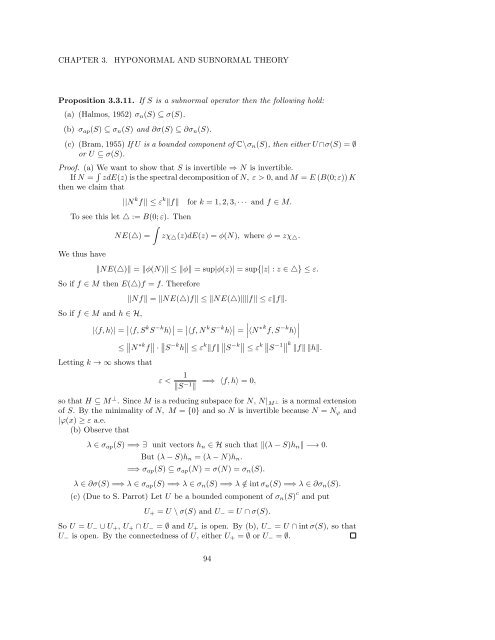Woo Young Lee Lecture Notes on Operator Theory
Woo Young Lee Lecture Notes on Operator Theory
Woo Young Lee Lecture Notes on Operator Theory
You also want an ePaper? Increase the reach of your titles
YUMPU automatically turns print PDFs into web optimized ePapers that Google loves.
CHAPTER 3.<br />
HYPONORMAL AND SUBNORMAL THEORY<br />
Propositi<strong>on</strong> 3.3.11. If S is a subnormal operator then the following hold:<br />
(a) (Halmos, 1952) σ n (S) ⊆ σ(S).<br />
(b) σ ap (S) ⊆ σ n (S) and ∂σ(S) ⊆ ∂σ n (S).<br />
(c) (Bram, 1955) If U is a bounded comp<strong>on</strong>ent of C\σ n (S), then either U ∩σ(S) = ∅<br />
or U ⊆ σ(S).<br />
Proof. (a) We want to show that S is invertible ⇒ N is invertible.<br />
If N = ∫ zdE(z) is the spectral decompositi<strong>on</strong> of N, ε > 0, and M = E (B(0; ε)) K<br />
then we claim that<br />
||N k f|| ≤ ε k ∥f∥ for k = 1, 2, 3, · · · and f ∈ M.<br />
To see this let △ := B(0; ε). Then<br />
∫<br />
NE(△) = zχ △ (z)dE(z) = ϕ(N), where ϕ = zχ △ .<br />
We thus have<br />
∥NE(△)∥ = ∥ϕ(N)∥ ≤ ∥ϕ∥ = sup|ϕ(z)| = sup{|z| : z ∈ △} ≤ ε.<br />
So if f ∈ M then E(△)f = f. Therefore<br />
∥Nf∥ = ∥NE(△)f∥ ≤ ∥NE(△)∥∥f∥ ≤ ε∥f∥.<br />
So if f ∈ M and h ∈ H,<br />
|⟨f, h⟩| = ∣ ∣⟨f, S k S −k h⟩ ∣ = ∣ ∣⟨f, N k S −k h⟩ ∣ ∣<br />
= ∣⟨N ∗k f, S −k h⟩ ∣<br />
Letting k → ∞ shows that<br />
≤ ∥ ∥N ∗k f ∥ ∥ · ∥∥S −k h ∥ ∥ ≤ ε k ∥f∥ ∥ ∥S −k∥ ∥ ≤ ε k ∥ ∥S −1∥ ∥ k ∥f∥ ∥h∥.<br />
ε < 1<br />
∥S −1 ∥<br />
=⇒ ⟨f, h⟩ = 0,<br />
so that H ⊆ M ⊥ . Since M is a reducing subspace for N, N| M ⊥ is a normal extensi<strong>on</strong><br />
of S. By the minimality of N, M = {0} and so N is invertible because N = N φ and<br />
|φ(x) ≥ ε a.e.<br />
(b) Observe that<br />
λ ∈ σ ap (S) =⇒ ∃ unit vectors h n ∈ H such that ∥(λ − S)h n ∥ −→ 0.<br />
But (λ − S)h n = (λ − N)h n .<br />
=⇒ σ ap (S) ⊆ σ ap (N) = σ(N) = σ n (S).<br />
λ ∈ ∂σ(S) =⇒ λ ∈ σ ap (S) =⇒ λ ∈ σ n (S) =⇒ λ /∈ int σ n (S) =⇒ λ ∈ ∂σ n (S).<br />
(c) (Due to S. Parrot) Let U be a bounded comp<strong>on</strong>ent of σ n (S) c and put<br />
U + = U \ σ(S) and U − = U ∩ σ(S).<br />
So U = U − ∪ U + , U + ∩ U − = ∅ and U + is open. By (b), U − = U ∩ int σ(S), so that<br />
U − is open. By the c<strong>on</strong>nectedness of U, either U + = ∅ or U − = ∅.<br />
94













